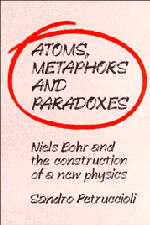Book contents
- Frontmatter
- Contents
- Introduction
- 1 The paradigm of complementarity
- 2 Atomic model and quantum hypotheses
- 3 The principle of correspondence
- 4 The theory of virtual oscillators
- 5 The conceptual foundation of quantum mechanics
- 6 The Bohr—Einstein confrontation: phenomena and physical reality
- General bibliography
- Name index
- General index
2 - Atomic model and quantum hypotheses
Published online by Cambridge University Press: 10 November 2009
- Frontmatter
- Contents
- Introduction
- 1 The paradigm of complementarity
- 2 Atomic model and quantum hypotheses
- 3 The principle of correspondence
- 4 The theory of virtual oscillators
- 5 The conceptual foundation of quantum mechanics
- 6 The Bohr—Einstein confrontation: phenomena and physical reality
- General bibliography
- Name index
- General index
Summary
In 1913 the Philosophical Magazine published a long article by Bohr in three parts containing the first quantum theory of the atom. The article was entitled ‘On the Constitution of Atoms and Molecules’ and soon became known in the scientific circles of the day as Bohr's ‘trilogy’. The article provided a sound theoretical foundation for the Rutherford model of the nuclear atom that had become established in 1911 thanks to new experimental discoveries about the elementary constituents of matter. The importance and originality of Bohr's paper are usually seen as lying in his successful use of quantum concepts in the solution of problems concerning the constitution and physical properties of atoms, thereby effecting a significant extension of the scope of the quantization hypotheses first introduced by Planck at the beginning of the century. Until 1910 physicists had – with few but important exceptions (in particular Einstein, von Laue and Ehrenfest) – generally been convinced that Planck's constant h was characteristic only of the problem of heat radiation, i.e. had seen it as a particular hypothesis making possible the theoretical derivation of the black-body law. Bohr's work would thus assume a two-fold importance in the evolution of 20th century physics. On the one hand, it would represent the first attempt to formulate a consistent theory of the constitution of the atom capable of explaining much of the experimental data available and of deducing empirical laws concerning the spectra of the elements. On the other, it would mark a decisive advance for quantum-theoretical conceptions by establishing their high level of generality.
- Type
- Chapter
- Information
- Atoms, Metaphors and ParadoxesNiels Bohr and the Construction of a New Physics, pp. 36 - 77Publisher: Cambridge University PressPrint publication year: 1993



